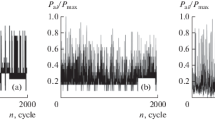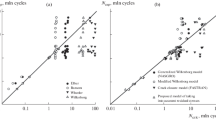Abstract
Based on the fatigue crack growth results of the previous work for 2024-T351 aluminum alloy, the crack closure behavior under random loading was analyzed, and the correlation between the crack opening ratio and the stress ratio under random loading was discussed. The crack opening ratio under random loading can be expressed as a function of the stress ratio for the largest load cycle in a random load history. The correlation obtained is found to provide good predictions for crack growth under random loading.
Similar content being viewed by others
References
W. Elber, Equivalent constant-amplitude concept for crack growth under spectrum loading, ASTM STP 595, ASTM, Philadelphia, PA, USA (1976) 236–250.
C. M. Hudson, A root-mean-square approach for predicting fatigue crack growth under random loading, ASTM STP 748, ASTM, Philadelphia, PA, USA (1981) 41–52.
J. C. Newman, A crack-closure model for predicting fatigue crack growth under aircraft spectrum loading, ASTM STP 748, ASTM, Philadelphia, PA, USA (1981) 53–84.
W. S. Johnson, Multi-parameter yield zone model for predicting spectrum crack growth, ASTM STP 748, ASTM, Philadelphia, PA, USA (1981) 85–102.
A. U. de Koning, A simple crack closure model for prediction of fatigue crack growth rates under variable amplitude loading, ASTM STP 743, ASTM, Philadelphia, PA, USA (1981) 63–85.
M. Kikukawa, M. Jono, Y. Kondo and S. Mikami, Fatigue crack closure and estimation method of crack propagation rate under stationary varying loading conditions including random loading (First report, effects of mean load and study on wave counting method), Transactions of JSME, 48 (1982) 1496–1504 (in Japanese).
M. Jono, J. H. Song and M. Kikukawa, Fatigue crack growth and closure of the structural materials under random loading, Proceedings of ICM, 6 (1984) 1735–1742.
R. Sunder, Near-threshold fatigue crack growth prediction under spectrum loading, ASTM STP 1122, ASTM, Philadelphia, PA, USA (1992) 161–177.
J. Schijve, M. Skorupa, A. Skorupa, T. Machniewicz and P. Gruszczynski, Fatigue crack growth in the aluminum alloy D16 under constant and variable amplitude loading, International Journal of Fatigue, 26 (2004) 1–15.
M. Skorupa, T. Machniewicz, J. Schijve and A. Skorupa, Application of the strip-yield model from the NASGRO software to predict fatigue crack growth in aluminum alloys under constant and variable amplitude loading, Engineering Fracture Mechanics, 74 (2007) 291–313.
Y. Yamada, B. Ziegler and J. C. Newman Jr, Application of a strip-yield model to predict crack growth under variable-amplitude and spectrum loading — Part 1: compact specimens, Engineering Fracture Mechanics, 78 (2011) 2597–2608.
C. Y. Kim and J. H. Song, Fatigue crack closure and growth behavior under random loading, Engineering Fracture Mechanics, 49 (1994) 105–120.
S. Y. Lee and J. H. Song, Crack closure and growth behavior of physically short fatigue cracks under random loading, Engineering Fracture Mechanics, 66 (2000) 321–346.
J. H. Song, C. Y. Kim and S. Y. Lee, Crack growth and closure of short and long cracks under random loading, Journal of ASTM International, 1(8) (2004) 1–15.
M. Jono, J. H. Song and A. Sugeta, Prediction of fatigue crack growth and closure under non-stationary random loading, Proceedings of ICOSSAR, 4 (1985) 465–474.
M. Jono, J. H. Song and A. Sugeta, Fatigue crack growth and closure under variable loadings (Effects of load variations on characteristic form of crack growth rate curve in region II), Journal of the Society of Material Science, 34 (1985) 1193–1199 (in Japanese).
C. M. Pang and J. H. Song. Crack growth and closure behavior of short fatigue cracks, Engineering Fracture Mechanics, 47 (1995) 327–343.
Author information
Authors and Affiliations
Corresponding author
Additional information
Recommended by Associate Editor Jin Weon Kim
Chung-Youb Kim is a professor at the School of Mechanical Design Engineering at Chonnam National University in Yosu, Korea. He received his B.S. from Korea University in 1986, and M.S. and Ph.D. from Korea Advanced Institute of Science and Technology in 1986 and 1993, respectively. His research interest is the fatigue strength evaluation of bulk and thin film materials.
Ji-Ho Song is now a professor emeritus in Mechanical Engineering, Korea Advanced Institute of Science and Technology (KAIST). He has published several books: Fundamentals of Mechanical Drawings, 2003. Fatigue Crack, Japanese Edition, 2005, Korean Edition, 2006. An Introduction to Reliability Engineering in Mechanical Design, 2007. Dictionary of Fatigue Fracture and Fatigue Strength of Materials (FatiguePedia of Materials), 2011.
Rights and permissions
About this article
Cite this article
Kim, CY., Song, JH. A formula for the crack opening level under random loading in 2024-T351 aluminum alloy. J Mech Sci Technol 28, 521–525 (2014). https://doi.org/10.1007/s12206-013-1119-2
Received:
Revised:
Accepted:
Published:
Issue Date:
DOI: https://doi.org/10.1007/s12206-013-1119-2




